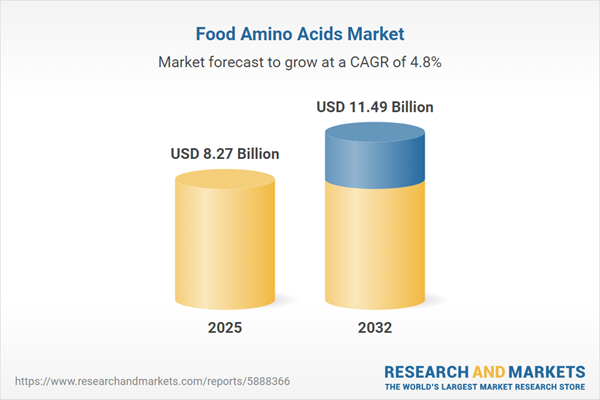Speak directly to the analyst to clarify any post sales queries you may have.
The global food amino acids market plays a pivotal role in supporting functional and innovative solutions across nutrition, animal feed, pharmaceuticals, and cosmetics. Senior decision-makers navigating this evolving landscape must monitor production technologies, supply chain resilience, and regulatory shifts to capitalize on opportunities and safeguard long-term growth.
Market Snapshot: Food Amino Acids Market Size and Growth Trajectory
The Food Amino Acids Market grew from USD 7.88 billion in 2024 to USD 8.27 billion in 2025. It is expected to continue expanding at a CAGR of 4.81%, reaching USD 11.49 billion by 2032. Market expansion is propelled by the increasing demand for specialized amino acid ingredients in food, animal nutrition, and pharmaceutical formulations. Changing consumer preferences for clean-label and personalized nutrition solutions combined with innovation in green chemistry and advanced fermentation processes support this upward trend. Disruption in supply chains and evolving regulatory requirements are fostering resilience and operational agility throughout the sector.
Scope & Segmentation: Defining Segment Relevance and Geographic Opportunities
This food amino acids market analysis provides detailed insights across application, type, sourcing, form, and purity grade, as well as in-depth regional breakdowns. The report also reviews key developments among leading companies.
- Application: Animal feed, cosmetics, food and beverage, nutraceuticals, pharmaceuticals
- Type: Glutamic acid, lysine, methionine, threonine
- Source: Chemical synthesis, fermentation (bacterial, mold, yeast), protein hydrolysis
- Form: Liquid, powder
- Purity Grade: Feed grade, food grade, pharma grade
- Region: Americas (United States, Canada, Mexico, Brazil, Argentina, Chile, Colombia, Peru), Europe, Middle East & Africa (UK, Germany, France, Russia, Italy, Spain, Netherlands, Sweden, Poland, Switzerland, UAE, Saudi Arabia, Qatar, Turkey, Israel, South Africa, Nigeria, Egypt, Kenya), Asia-Pacific (China, India, Japan, Australia, South Korea, Indonesia, Thailand, Malaysia, Singapore, Taiwan)
- Major Players: Ajinomoto Co., Inc., Archer Daniels Midland Company, Evonik Industries AG, Koninklijke DSM N.V., Kyowa Hakko Bio Co., Ltd., CJ CheilJedang Corp., Shandong Fufeng Group Co., Ltd., Meihua Holdings Group Co., Ltd., Sumitomo Seika Chemicals Co., Ltd., Shandong Jiejing Group Co., Ltd.
Key Takeaways: Strategic Insights Shaping the Food Amino Acids Market
- Advances in fermentation technology and green chemical synthesis are central to yield optimization and minimizing the environmental footprint in amino acid production.
- Consumer expectations for sustainability, traceability, and personalized nutrition are increasing demand for premium and specialty amino acid formulations across all major end-use industries.
- Regional manufacturers are leveraging local raw material availability and regulatory incentives to enter niche markets, while established multinationals pursue mergers, process enhancements, and portfolio diversification.
- Strategic collaborations with research institutions and digital process control are enabling industry leaders to rapidly validate new production methodologies and improve operational efficiency.
- Supply chain disruptions and geopolitical factors are causing a renewed focus on nearshoring, alternative sourcing strategies, and inventory management to safeguard continuity and control costs.
Tariff Impact on Global Supply Chains and Competitive Dynamics
The 2025 United States tariff measures have prompted companies to adapt sourcing models, diversify supplier bases, and explore new production geographies. Tariff-related cost pressures have accelerated investment in alternative feedstocks, while regional producers benefit from closer proximity to end markets and flexible logistics. As global companies apply tariff mitigation mechanisms, the competitive landscape is reshaping in favor of supply chain resilience.
Food Amino Acids Market: Methodology & Data Sources
This research relies on a rigorous, multi-phase methodology. Secondary research incorporated leading scientific literature, industry whitepapers, and regulatory documentation. Structured primary interviews with executives and technical experts were conducted internationally, supported by quantitative surveys spanning multiple segments. Data triangulation, SWOT and PESTEL analysis, and competitive benchmarking underpin robust, validated conclusions.
Why This Report Matters: Decision-Support for Industry Leaders
- Supports senior leaders in aligning investment strategy with evolving market priorities, regulatory shifts, and competitive pressures in the food amino acids sector.
- Equips procurement and operations teams with intelligence on supply chain adaptation, emerging sourcing models, and futureproof technology adoption.
- Enables research, business development, and commercial managers to identify new growth opportunities across applications, regions, and innovation partnerships.
Conclusion
The food amino acids market is shaped by advances in production, supply chain strategy, and consumer demands for sustainability. This report delivers targeted intelligence to help organizations refine strategy, foster resilience, and position for long-term growth in a dynamic global environment.
Additional Product Information:
- Purchase of this report includes 1 year online access with quarterly updates.
- This report can be updated on request. Please contact our Customer Experience team using the Ask a Question widget on our website.
Table of Contents
3. Executive Summary
4. Market Overview
7. Cumulative Impact of Artificial Intelligence 2025
Companies Mentioned
The companies profiled in this Food Amino Acids market report include:- Ajinomoto Co., Inc.
- Archer Daniels Midland Company
- Evonik Industries AG
- Koninklijke DSM N.V.
- Kyowa Hakko Bio Co., Ltd.
- CJ CheilJedang Corp.
- Shandong Fufeng Group Co., Ltd.
- Meihua Holdings Group Co., Ltd.
- Sumitomo Seika Chemicals Co., Ltd.
- Shandong Jiejing Group Co., Ltd.
Table Information
| Report Attribute | Details |
|---|---|
| No. of Pages | 185 |
| Published | November 2025 |
| Forecast Period | 2025 - 2032 |
| Estimated Market Value ( USD | $ 8.27 Billion |
| Forecasted Market Value ( USD | $ 11.49 Billion |
| Compound Annual Growth Rate | 4.8% |
| Regions Covered | Global |
| No. of Companies Mentioned | 11 |









